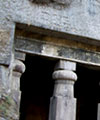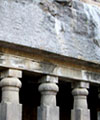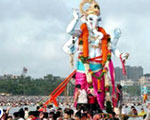| Encyclopedia of Tours and Travel to Maharashtra, featuring information on Fairs & Festivals, Wildlife, Excursion, Adventure and Weather of Maharashtra. |
 |
 |
 |
 |
 |
 |
 |
||
|
Nasik
Places to Visit [ Gangapur Dam | Yashwantrao Maharaj Memorial | Deolali Camp | Artillery Centre | Bhagur | Takli | Nandur Madhameshwar Bird Sanctuary | Igatpuri | Satana | Malegaon | Dindori | Nandgaon | Niphad | Yeola | Nasik Road ] Gangapur Dam Nasik has a personality of its own due to its mythological, historical, social and cultural importance. The river Godavari flows through the city. Temples and ghats on the banks of Godavari have made Nasik one of the holiest places for Hindus all over the World. In a true way the city can be called as city of Temples. The section gives the description of the temples in & around the city. It also covers the Holy Events taking place in the city. Yashwantrao Maharaj Memorial Deolali Camp In the days of the British Raj, soldiers who cracked up under the stresses and strains of life in British India were invariably packed off to a military psychiatric hospital in the small Maharashtrian cantonment town of Deolali, near Nasik, to recover. Its name became synonymous with nervous breakdown; hence the English idiom "to go doolally", meaning to become insane or eccentric. Artillery Centre
Bhagur Takli Nandur Madhameshwar Bird Sanctuary Igatpuri The highest peaks in Sahyaadri i.e. Western Ghats surrounds Igatpuri, most of them are forts built in Satavahana dynasty. It's heavenly for trekkers and hikers, Most bollywood movie outdoor scenes especially songs are shot in Igatpuri region. This region consists of those mountains, which are accessed by trains going from Mumbai CST to Kasara and Igatpuri. Local trains only go upto Kasara, and don't climb the Thal Ghat from Kasara to Igatpuri. Hence to go to Igatpuri, one has to either take a long distance train or reach Kasara and then take a bus. The first local train to Kasara leaves Mumbai CST at 4:00am, and the last train at 11:15pm. The Mahanagari express leaves Mumbai CST at 11:55 and goes via Igatpuri. It takes 3 hours to reach Kasara by a slow local, and 3 hours to reach Igatpuri by a long distance mail/express train. Kasara is 120km from Mumbai, whereas Igatpuri is 136km away. Igatpuri Resort Vipassana, one of India's most ancient meditation techniques, is traced to Gautama the Buddha. It is the process of self-purification by self-observation. One begins by observing the natural breath to develop concentration and then moves on to observe the changing nature of body and mind and experiences the universal truths of impermanence, suffering and egolessness. Vipassana, which means, "to see things as they really are", is a logical and pure natural science. Its practitioners claim that as a by-product of mental purification, many psychosomatic diseases also get eradicated. With continued practice, the meditation relieves the tensions of everyday life and develops positive, creative energy for the betterment of the individual and society. Vipassana International Academy offers you an opportunity to learn the path to Dhamma - Goutama Buddha's technique of meditation. To learn Vipassana, it is necessary to take a ten-day residential course under the guidance of a qualified teacher. These courses are open to anyone who sincerely wishes to learn the technique. People from all backgrounds find that they become better human beings. Thus, without conflict, it cuts across barriers of race, caste or religion, in any place, at any time and will prove equally beneficial to one and all. If you enrol for the retreat you will remain within the course site having no contact with the outside world for the duration of the retreat. You will follow a demanding daily schedule that includes about 10 hours of sitting meditation. You will also observe silence, not communicating with fellow students. There are three steps to the training. Advance Booking At most times the course is completely booked. It's better to make bookings at least two months in advance. This can be done online for the dhamma Giri centre as of now.
Boarding and Lodging Accommodation: The centre has comfortable accommodation for about 600 students, in addition to living quarters for the Dhamma workers (volunteers), kitchen staff and a separate accommodation quarters for monks (bhikkhus) who come for the course. There is no charge for accommodation. You may give a donation if you so wish. Food : Meals at the ashram are provided free of cost at fixed times. Daily Schedule : 4:00 a.m. : Morning wake-up bell Contact Details: Dhamma Giri, Igatpuri
Satana Malegaon Dindori Nandgaon The state's foundation is traced to a religious celibate, who came from the Punjab towards the end of the 18th century. From the founder it passed through a succession of chosen disciples until 1879, when the British government recognized the ruler as an hereditary chief and afterwards conferred upon his son the title of Raja Bahadur. After the construction of the Bengal-Nagpur railway, it gained in prosperity and had a station at Rajnandgaon, the capital of the state. After India became independent in 1947, the state joined the Indian Union and later became a part of the state of Madhya Pradesh. Nandgaon is now part of the state of Chhattisgarh, which split from Madhya Pradesh in 2000. Niphad
Yeola Sennar or Sannar, town, E Sudan, on the Blue Nile. It was the capital of the Muslim kingdom of Sennar, traditionally known as the "Black Sultanate," which was founded in the 16th cent. Under its strongest rulers, Sennar extended over most of the eastern part of the present Sudan. The kingdom declined in the 18th cent and was annexed in 1821 by Egypt, then a part of the Ottoman Empire. The old capital lies abandoned near modern Sennar. The Sennar Dam, completed in 1925, is used for crop irrigation. Nasik Road Nasik Road is home to almost 150,000 residents and is one of the fastest growing suburbs of Nasik. The India Security Press (the National treasury press) was the biggest employer in Nasik Road for many decades until the late eighties when a service-based economy started to thrive. Muktidham, a marble temple complex honoring various Hindu Gods is a popular tourist attraction. The Nasik-Pune highway (NH 50), the Bhagur-Nasik road (Lam road), Jail Road are some of the major roads in the city, alongside the residential and commercial neighbourhoods. The first and only road flyover of the city is in Nasik Road over the NH 50 and has helped reduce the traffic congestion in peak hours in the area. Dattamandir, Andhashala, Gandharvanagari, Shikhrewadi, Jailroad, Gaykhe mala, Jai Bhavani road, Upanagar, and the old downtown Nasikroad are major residential areas. Nasik Road railway station is an important stop for trains on the Mumbai-Bhusawal-Delhi and Mumbai-Bhusawal-Nagpur-Kolkata Central Railway routes. Heavy passenger traffic is a daily feature of the Nasik Road-Mumbai railway sector. Nasik Road is a fast developing city suburb and has many hotels and restaurants, educational institutions (St. Xavier's, St. Philomena's, Purushottam, Progressive etc.), hospitals and financial institutions (Business Bank, Vyapari Bank etc.) catering to the growing needs of the population. Nasik is a district head quarters located on the banks of Godavari and is 185 km away from Mumbai. The climate is moderate, and is located at 635 m above mean sea level. The city has developed on both the banks of Godavari which divides the city into almost equal halves. The History of the city dates back to Ramayana. There are many references of the city in many epics as well as vedas. Today the city has developed into a metropolis with a population of 14 lakh souls. The city since old days have developed on the banks with basically the design of a religious place How-ever today it has been a flourishing Industrial Centre as well as an educational centre.
|
||||||||||
|
||||||||||
|
||||||||||
|---|---|---|---|---|---|---|---|---|---|---|